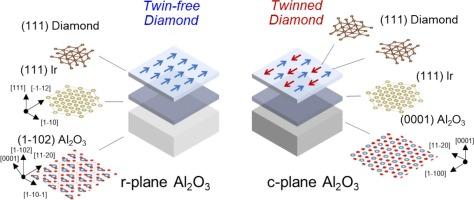Twin-free (111) single-crystal diamond heteroepitaxially grown on (1-102) sapphire substrate
IF 5.1
3区 材料科学
Q2 MATERIALS SCIENCE, COATINGS & FILMS
引用次数: 0
Abstract
We report, for the first time, the successful heteroepitaxial growth of twin-free single-crystal (111) diamond on the r-plane (1-102) α-Al₂O₃ (sapphire) substrate. Through a comparative study with (111) diamond grown on a c-plane (0001) sapphire substrate, it is demonstrated that the suppression of twin domain formation on the r-plane originates from its one-fold in-plane symmetry. X-ray diffraction φ-azimuthal scans and pole figure analyses confirm the single-domain growth of (111) diamond on the r-plane sapphire, whereas twinned (111) domains are formed on the c-plane sapphire, reflecting its underlying trigonal symmetry, which results in unequal intensities of the twin domains. A 21.5 μm-thick (111) diamond template grown on the r-plane substrate exhibited excellent crystallinity, with X-ray rocking curve full width at half maximum (FWHM) values of 0.55° and 0.23° for the (111) and (311) planes, respectively. These results suggest a viable pathway for the fabrication of twin-free, high-quality free-standing (111) diamond substrates, enabling advanced power and quantum devices, and opening the possibility for hybrid integration with III-nitride semiconductors.

在(1-102)蓝宝石衬底上异质外延生长的无双(111)单晶金刚石
我们首次报道了在r平面(1-102)α-Al₂O₃(蓝宝石)衬底上成功生长无双单晶(111)金刚石。通过与(111)金刚石在c平面(0001)蓝宝石衬底上生长的比较研究,证明了在r平面上抑制孪晶畴的形成源于它的一层面内对称性。x射线衍射φ-方位角扫描和极图分析证实了(111)钻石在r面蓝宝石上的单畴生长,而在c面蓝宝石上形成双晶(111)畴,反映了其潜在的三角对称性,这导致双晶畴强度不相等。在r面基底上生长的21.5 μm(111)厚的金刚石模板显示出良好的结晶度,(111)和(311)面的x射线摆动曲线半最大全宽(FWHM)分别为0.55°和0.23°。这些结果为制造无双、高质量的独立(111)金刚石衬底提供了一条可行的途径,使先进的功率和量子器件成为可能,并为与iii -氮化物半导体的混合集成开辟了可能性。
本文章由计算机程序翻译,如有差异,请以英文原文为准。
求助全文
约1分钟内获得全文
求助全文
来源期刊

Diamond and Related Materials
工程技术-材料科学:综合
CiteScore
6.00
自引率
14.60%
发文量
702
审稿时长
2.1 months
期刊介绍:
DRM is a leading international journal that publishes new fundamental and applied research on all forms of diamond, the integration of diamond with other advanced materials and development of technologies exploiting diamond. The synthesis, characterization and processing of single crystal diamond, polycrystalline films, nanodiamond powders and heterostructures with other advanced materials are encouraged topics for technical and review articles. In addition to diamond, the journal publishes manuscripts on the synthesis, characterization and application of other related materials including diamond-like carbons, carbon nanotubes, graphene, and boron and carbon nitrides. Articles are sought on the chemical functionalization of diamond and related materials as well as their use in electrochemistry, energy storage and conversion, chemical and biological sensing, imaging, thermal management, photonic and quantum applications, electron emission and electronic devices.
The International Conference on Diamond and Carbon Materials has evolved into the largest and most well attended forum in the field of diamond, providing a forum to showcase the latest results in the science and technology of diamond and other carbon materials such as carbon nanotubes, graphene, and diamond-like carbon. Run annually in association with Diamond and Related Materials the conference provides junior and established researchers the opportunity to exchange the latest results ranging from fundamental physical and chemical concepts to applied research focusing on the next generation carbon-based devices.
 求助内容:
求助内容: 应助结果提醒方式:
应助结果提醒方式:


